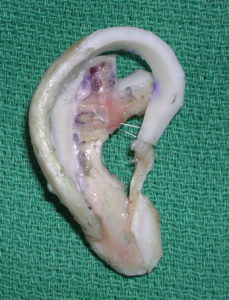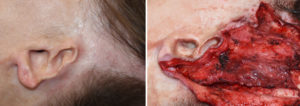Ear reconstruction of congenital or traumatic injuries often involves the need for multiple tissue layers to rebuild the ear. A cartilage framework and a vascularized layer on top of the cartilage onto which a skin graft is placed on its outer surface is essential in many major full thickness ear absences or losses. In creating the framework for whatever part of the ear is missing it is important to remember that only the raised or convex surfaces of the ear need a framework. All concave contours of the ear can be unsupported and allowed to collapse in between the convex framework segments.

While the subcostal rib lengths are adequate they must be thinned and bent into an arc-like shape. The ability to do so depends on the natural elasticity of the cartilage. In children and teens this is never a problem but can be so in adults particularly older adults. As one ages the ribs develop variable amounts of calcification and become stiffer. When thinned and bent they become more brittle and prone to fracture.
A technique I have found useful in adult rib shaping for ears is to use a metal template to support a long bend into an arc shape. Specifically a 1.5mm thin titanium fixation plate can be used. The desired bend is first made in the metal plate to which the rib cartilage is then attached by permanent sutures with the knots on the inside. There even a brittle rib in an older adult can get the desired shape that is stable.

Dr. Barry Eppley
Indianapolis, Indiana




